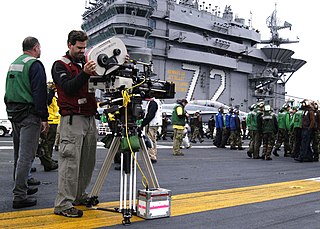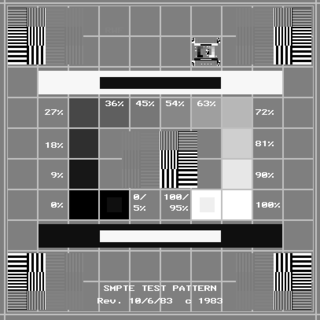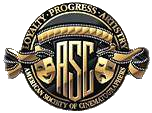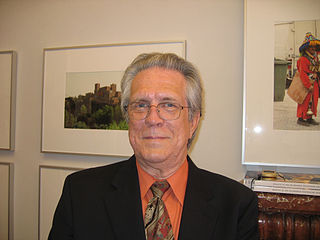Digital cinema refers to the use of digital technology to distribute or project motion pictures as opposed to the historical use of reels of motion picture film, such as 35 mm film. Whereas film reels have to be shipped to movie theaters, a digital movie can be distributed to cinemas in a number of ways: over the Internet or dedicated satellite links, or by sending hard drives or optical discs such as Blu-ray discs. Digital movies are projected using a digital video projector instead of a film projector. Digital cinema is distinct from high-definition television and does not necessarily use traditional television or other traditional high-definition video standards, aspect ratios, or frame rates. In digital cinema, resolutions are represented by the horizontal pixel count, usually 2K or 4K. As digital-cinema technology improved in the early 2010s, most of the theaters across the world converted to digital video projection.

35 mm film (millimeter) is the film gauge most commonly used for motion pictures and chemical still photography. The name of the gauge refers to the width of the photographic film, which consists of strips 34.98 ±0.03 mm (1.377 ±0.001 inches) wide. The standard negative pulldown for movies is four perforations per frame along both edges, which results in 16 frames per foot of film. For still photography, the standard frame has eight perforations on each side.

A cinematographer or director of photography is the chief over the camera and light crews working on a film, television production or other live action piece and is responsible for making artistic and technical decisions related to the image. The study and practice of this field is referred to as cinematography.

The Society of Motion Picture and Television Engineers (SMPTE), founded in 1916 as the Society of Motion Picture Engineers or SMPE, is a global professional association, of engineers, technologists, and executives working in the media and entertainment industry. An internationally recognized standards organization, SMPTE has more than 800 Standards, Recommended Practices, and Engineering Guidelines for broadcast, filmmaking, digital cinema, audio recording, information technology (IT), and medical imaging. In addition to development and publication of technical standards documents, SMPTE publishes the SMPTE Motion Imaging Journal, provides networking opportunities for its members, produces academic conferences and exhibitions, and performs other industry-related functions.

Cinematography is the science or art of motion-picture photography by recording light or other electromagnetic radiation, either electronically by means of an image sensor, or chemically by means of a light-sensitive material such as film stock.

Philip H. Lathrop, A.S.C. was an American cinematographer noted for his skills with wide screen technology and detailed approach to lighting and camera placement. He spent most of his life in movie studios. Lathrop was known for such films as Touch of Evil (1958), Lonely Are the Brave (1962), The Americanization of Emily (1964), The Cincinnati Kid (1965), Point Blank (1967), Finian's Rainbow (1968), The Traveling Executioner (1970), Portnoy's Complaint (1972), Earthquake (1974), Swashbuckler (1976), The Driver (1978), Moment by Moment (1978), A Change of Seasons (1980), Foolin' Around (1980), Loving Couples (1980), and Deadly Friend (1986).

1 inch type B VTR is a reel-to-reel analog recording video tape format developed by the Bosch Fernseh division of Bosch in Germany in 1976. The magnetic tape format became the broadcasting standard in continental Europe, but adoption was limited in the United States and United Kingdom, where the Type C videotape VTR was met with greater success.

Univisium is a proposed universal film format created by cinematographer Vittorio Storaro, ASC, AIC and his son, Fabrizio, to unify all future theatrical and television movies into one respective aspect ratio of 2:1. The proposed format also includes new standards for projection to maximize the efficiencies of the Univisium format.
Lori McCreary is an American motion picture producer and computer scientist. She is CEO of the production company Revelations Entertainment, which she co-founded with actor Morgan Freeman.
Parallax scanning depth enhancing imaging methods rely on discrete parallax differences between depth planes in a scene. The differences are caused by a parallax scan. When properly balanced (tuned) and displayed, the discrete parallax differences are perceived by the brain as depth.
CineForm Intermediate is an open source video codec developed for CineForm Inc by David Taylor, David Newman and Brian Schunck. On March 30, 2011, the company was acquired by GoPro which in particular wanted to use the 3D film capabilities of the CineForm 444 Codec for its 3D HERO System.
The aspect ratio of an image describes the proportional relationship between its width and its height. It is commonly expressed as two numbers separated by a colon, as in 16:9. For an x:y aspect ratio, no matter how big or small the image is, if the width is divided into x units of equal length and the height is measured using this same length unit, the height will be measured to be y units.

The American Cinematographer Manual is a filmmaking manual published by the American Society of Cinematographers. Covering lighting, lenses, and film emulsions, it is considered “an authoritative technical reference manual for cinematographers.” The manual also defines the cinematography profession.
Ira Alan Tiffen is an optics designer and glass artist who worked at the Tiffen Company from 1973 to 2004. He has been the recipient of both an Academy Award and an Emmy Award for his technical achievements in motion picture photography and video imaging.

Milton R. Shefter is a Los Angeles-based film and media-asset archivist and preservationist. He is best known for the creation, design, and management of the extensive Paramount Pictures Asset Protection Program, and for co-authoring the landmark 2007 report from the Science and Technology Council of the Academy of Motion Picture Arts and Sciences, The Digital Dilemma, as well as its 2012 followup, The Digital Dilemma 2.

John Arnold was an American cinematographer. He began in 1914, and in his 25 years behind the camera, he shot 86 films. He also worked in film administration, directing the cinematography department at MGM, and was president of the American Society of Cinematographers from 1931 through 1937, and again from 1939 to 1941. By 1938, he was regarded as one of the most authoritative experts on cinematography. He invented several pieces of camera equipment and was awarded two Oscars, both Technical Achievement Awards. The first was in 1938 for improvements on the semi-automatic follow focus device used on motion picture cameras, while the second was in 1940 for the development of the MGM mobile camera crane.

Variety is a weekly American entertainment trade magazine and website owned by Penske Media Corporation. It was founded by Sime Silverman in New York in 1905 as a weekly newspaper reporting on theater and vaudeville. In 1933 it added Daily Variety, based in Los Angeles, to cover the motion-picture industry. Variety.com features breaking entertainment news, reviews, box office results, cover stories, videos, photo galleries and more, plus a credits database, production charts and calendar, with archive content dating back to 1905.
American Cinematographer is a magazine published monthly by the American Society of Cinematographers. It focuses on the art and craft of cinematography, covering domestic and foreign feature productions, television productions, short films, music videos and commercials. The emphasis is on interviews with cinematographers, but directors and other filmmakers are often featured as well. Articles include technical how-to pieces, discussions of tools and technologies that affect cinematography, and historical features.
Digital Cinema Initiatives, LLC (DCI) is a joint venture of major motion picture studios, formed to establish a standard architecture for digital cinema systems.












